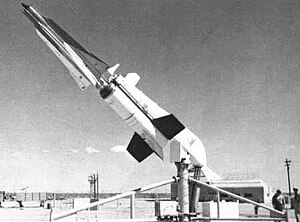RIM-50 Typhon
| RIM-50 Typhon LR RIM-55 Typhon MR | |
|---|---|
 Typhon LR on launcher | |
| Type | Long rangesurface-to-air missile |
| Place of origin | United States |
| Service history | |
| Used by | United States Navy |
| Production history | |
| Manufacturer | Bendix Corporation |
| Specifications (Typhon LR) | |
| Mass | 1,700 lb (770 kg) without booster 3,620 lb (1,640 kg) with booster |
| Length | 15 ft 6 in (4.72 m) without booster 27 ft 7 in (8.41 m) with booster |
| Diameter | 16 in (410 mm) missile 18.5 in (470 mm) booster |
| Wingspan | 3 ft 4 in (1.02 m) missile 5 ft 2 in (1.57 m) booster |
| Warhead | 150 lb (68 kg)high explosive orW60nuclear |
Detonation mechanism | Proximity fuse |
| Engine | Booster,solid-propellant rocket Sustainer, Bendixramjet |
Operational range | 200 nmi (230 mi; 370 km) |
| Flight ceiling | 95,000 ft (29,000 m) |
| Maximum speed | Mach4.0 |
Guidance system | Inertialcruise;SARHterminal |
| References | Parsch 2001a[1] |
Typhonwas a missile system developed by theUnited States Navyin the late 1950s, intended to serve as an integrated air-defense system for Navy fleets. Consisting of theSAM-N-8 Typhon LR,later designatedRIM-50A,and theSAM-N-9 Typhon MR,laterRIM-55A,paired with theAN/SPG-59radar system, the cost of the Typhon system led to it being cancelled in favor of theStandard Missileprogram.
Design and development[edit]
Development of Typhon was initiated in the late 1950s, as the existingTalos,Terrier,andTartar( "3 Ts" ) long-, medium-, and short-ranged missiles were considered to be approaching obsolescence;[2]in the event of a mass attack by Soviet bomber forces, the requirement for each missile to have its own dedicatedtarget illuminatorwould lead to rapid saturation of the defensive system. The Typhon system, developed under a contract awarded to theBendix Corporation,would overcome this through the use of theAN/SPG-59electronically scanned arrayradar system, capable of tracking and engaging multiple targets simultaneously.[3]
The missile system to complement the radar was originally named Super Talos (long-range) and Super Tartar (short-range), but to avoid confusion with upgrades for the existing missiles was soon renamed Typhon.[1]Typhon LR, the only version of the Typhon missile system to be test-flown, wasramjet-powered and capable of intercepting high-speed aircraft and missiles. It could engage targets in theMach3–4 range at between 50 feet (15 m) to 95,000 feet (29,000 m) altitude and 6,000 yards (5,500 m) to 110 nautical miles (130 mi; 200 km) range. A secondary capability in thesurface-to-surfacerole, capable of targeting enemy ships, was also included in the specification.[1]While primarily intended to be armed with a conventionalhigh explosivewarhead, Typhon LR was designed to be capable of carrying theW60 nuclear warhead.[4]
Typhon MR was designed to be capable of intercepting aircraft at between 50 feet (15 m) to 50,000 feet (15,000 m) in altitude and 3,000 yards (2,700 m) to 25 nautical miles (29 mi; 46 km) range. It had yet to enter testing before the Typhon project was cancelled.[5]
Operational history[edit]
In March 1961, the first test launches of the SAM-N-8 Typhon LR took place;[1]beginning in 1962, the test shipUSSNorton Soundentered refit to install the Typhon Weapon Control System to allow at-sea tests to be undertaken.[6]However, the expense of the Typhon system, combined with the technical issues encountered during development, led to the program being cancelled in November 1963. The conversion ofNorton Soundwas allowed to be completed to provide test data,[7]with the ship recommissioning in June 1964; following the tests, the Typhon equipment was removed in July 1966.[6]
In lieu of Typhon, the U.S. Navy developed theStandard Missilefamily to provide air defense for the fleet, with theRIM-66 StandardandRIM-67 Standard ERmissiles replacing Tartar and Terrier, respectively.[1]
See also[edit]
References[edit]
Citations[edit]
Bibliography[edit]
- Boslaugh, David L. (1999).When Computers Went to Sea: The Digitization of the United States Navy.Los Alamitos, CA: Institute of Electrical and Electronics Engineers Computer Society Press.ISBN0-471-47220-4.
- "Norton Sound".Dictionary of American Naval Fighting Ships, N-Q.Washington, DC: Naval Historical Center. 1970.Retrieved2017-12-20.
- Parsch, Andreas (30 September 2001)."Bendix SAM-N-8/RIM-50 Typhon LR".Directory of U.S. Military Rockets and Missiles.Designation-Systems.Retrieved2017-12-20.
- Parsch, Andreas (30 September 2001)."Bendix SAM-N-9/RIM-55 Typhon MR".Directory of U.S. Military Rockets and Missiles.Designation-Systems.Retrieved2017-12-20.
- Polmar, Norman;Robert S. Norris (2009).The U.S. Nuclear Arsenal:A History of Weapons and Delivery Systems since 1945(1st ed.). Annapolis, MD: Naval Institute Press.ISBN978-1-5575-0681-8.
- Senate Committee on Appropriations (1964).Department of Defense Appropriations, 1965: Hearings Before the Subcommittee on Department of Defense of the Committee on Appropriations and the Committee on Armed Services, United States Senate, Eighty-eighth Congress, Second Session on H.R. 10939.Washington, D.C.: Government Printing Office.Retrieved2017-12-20.
External links[edit]
- RIM-50 Typhonat GlobalSecurity.org
